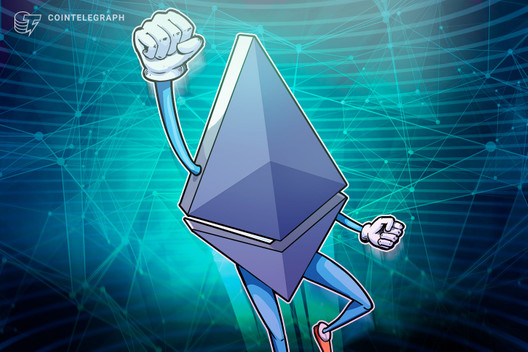Ether Price Hits 2020 High: Key Reasons Why ETH Outperforms Others
The price of Ether has hit a new yearly high at $322, as three key factors appear to be catalyzing the rally.
The price of Ethereum (ETH) has reached a new yearly high at $322, surpassing the previous high achieved in February 2020. Three key catalysts are seemingly behind the ETH rally.
Since early 2020, the anticipation of Ethereum 2.0, which would enable staking for users, pushed the demand for ETH upward. Staking allows users to receive incentives when miners are eliminated from the Ethereum network. A proof-of-stake consensus algorithm does not need miners on the protocol. Instead, users with a stake in ETH collectively process data and information through staking. In return, they receive rewards in the form of ETH.
After the so-called “Black Thursday” correction on March 13, when ETH briefly dropped below $90, the DeFi market began to expand rapidly. When new protocols, like Compound, introduced their incentive systems, the demand for decentralized finance increased even further. In May, less than $1 billion was locked in DeFi platforms. As of July 26, more than $3.75 billion is locked across various DeFi protocols.
The optimism around DeFi and Ethereum 2.0 eventually led to Ether spot and options markets setting record high volume and open interest. Since the start of the second quarter, the ETH options market has continuously soared to new highs in terms of trading activity. Consequently, it intensified the uptrend of ETH in a short period.
Cryptocurrency on-chain market data analysis firm Santiment said ETH broke out of $300 for the 42nd time in history. An upsurge above $350 would be significant, according to researchers, because it has only happened three times in the past. Santiment stated in a tweet: “It’s clear that #Ethereum is sitting in its ‘sweet spot’ where the most polarization has historically unfolded (between the $200 and $300 levels) during its five year history.”

Times the price of Ether surged above every major price level. Source: Santiment
Based on the technical market structure of Ether, some traders said that $308 and $400 remain as the key short-term resistance levels. Michaël van de Poppe, a Cointelegraph contributor and a full-time trader at the Amsterdam Stock Exchange, said in a tweet that ETH has increased higher than expected: “Going a little higher than the plan initially was, a month ago. But we’re doing fine. Might be on the resistance at the $308 level. But that’s basically final hurdle before $400+, to me.”
Reason #1: DeFi exploding to new highs
The first and perhaps biggest catalyst of the Ether uptrend in recent months has been the exploding DeFi market. Since May, the total value locked in DeFi protocols has increased nearly four-fold to $3.75 billion. Popular protocols, like Compound, Maker, Aave, Synthetic and Curve Finance, have seen a substantial increase in users since mid-June.
The DeFi market has been expanding at such a rapid pace that the Ethereum blockchain network is struggling to keep up. When users utilize DeFi platforms, they need to send data in the form of transactions and smart contracts. In most cases, users have to utilize decentralized exchanges to purchase various tokens.
In the past month, the Ethereum blockchain network has become overcrowded. As the network clogs, users are required to pay higher gas or transaction fees to process their payments or smart contracts. John Todaro, the head of research at the institutional trading platform TradeBlock, said on Twitter that the growth of DeFi would push the price of ETH higher in the long-term:
“Look back to a report we published in 2019 around the impact DeFi could have on #Ethereum demand. We have not seen that run-up in $ETH price yet, but there is no doubt the rapid growth in demand for DeFi will push ETH price higher longer term.”
The DeFi craze has also been fueling other submarkets within Ethereum. For example, Set Protocol marketing lead Anthony Sassano pointed out that the weekly dex volume has increased to $1.5 billion. Other key markets within Ethereum have started to set new all-time highs on various metrics as a result.
In the past year, total value locked in DeFi protocols has risen from $500 million to $3.4 billion. Sassano explained that it shows exponential growth in a short period. He noted: “There was $3 billion locked in DeFi just 2 days ago which means that $400 million has entered the system since then – it took DeFi ~18 months to go from $0 to $400 million the first time!”
Reason #2 and #3: Ethereum 2.0 with rising options and spot demand
Especially since the beginning of the second quarter of 2020, the Ethereum market has seen high options and spot demand. Previous rallies have been led by the futures market. The funding rate of Ether during the February 2020 peak was hovering at 0.2% on BitMEX. That means long holders had to incentivize short holders with substantial fees due to market imbalance.
During the recent rally, the funding rate of Ether futures contracts stayed relatively low. Despite a 30% increase in the past five days, the funding rate of ETH on BitMEX is well below 0.2%. It is likely due to the spot and options market playing a big role in ETH’s ongoing rally.
On July 24, the Deribit team said it had reached a record high for ETH options volume and open interest. Deribit accounts for 93% of the Ether options market in terms of open interest, tweeting: “We have a new record high for ETH Options volume and open interest! With a peak 24hr volume of $49 million, the Deribit ETH options OI sits at $241 million (and currently 93% of the global Ethereum market share)!”
Santiment researchers also noted ETH does have room for additional growth, relative to the performance of leading altcoins. Cryptocurrencies like Chainlink’s LINK have hit new highs in July, significantly outperforming top crypto assets. Possibly due to the lack of involvement of the futures market in the Ether rally, some analysts see a room for a bigger rally for ETH. Santiment stated on Twitter:
“The top 100 market cap #blockchains in the past 30 days show that $ETH still has a long way to go to catch most other #altcoins. This is a positive sign for current #Ethereum holders, currently +16.3% in the last 30d vs. an avg. top 100 return of +32.7%.”
In the longer-term, Ethereum 2.0 could act as a newfound catalyst, especially as ETH approaches Q4 2020. Earlier this week, Ethereum developers, led by fork coordinator Afri Schoedon, said that the official testnet launch of Ethereum 2.0 would begin on August 4.
The first phase of Ethereum 2.0 is called the beacon chain. For it to be activated or launched, developers need to develop testnets to mimic the conditions of the beacon chain. Stable and long-term testnets are necessary to ensure a seamless launch of Ethereum 2.0, Schoedon wrote on GitHub. The Medalla testnet is expected to be the final testnet before the mainnet launch, as Schoedon said:
“Before such a mainnet can be launched, we need testnets that mimic mainnet conditions as good as possible. This requires us to have stable, long-term, and persistent testnets up and running that are supported by not only one client but multiple clients, ideally, all clients.”
Positive progress on Ethereum 2.0, specifically on the Medalla testnet, could further boost the sentiment around Ether in the coming months. A confluence of rapidly-growing DeFi market and growing demand on the spot and options market, combined with Ethereum 2.0 hype, appear to be fueling a strong ETH rally.




